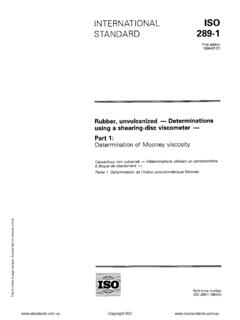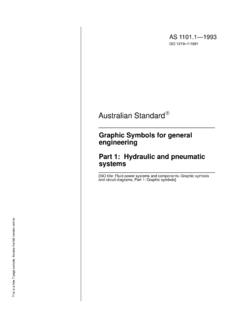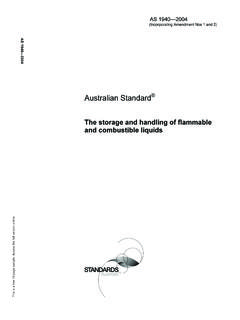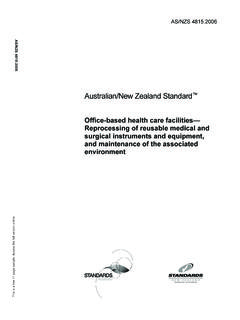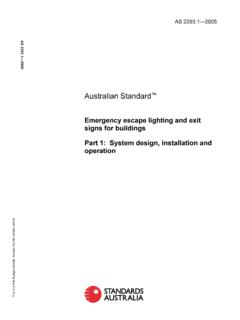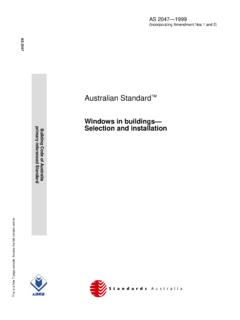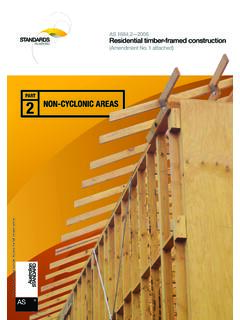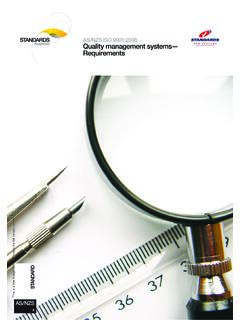Transcription of Australian/New Zealand Standard - SAI Global
1 AS/NZS 4146:2000 Australian/New Zealand Standard Laundry practiceAS/NZS 4146 This is a free 9 page sample. Access the full version 4146:2000 This J oint Australian/New Zealand Standard was prepared by J oint TechnicalCommittee TX/16, Laundry Practice. It was approved on behalf of the Council ofStandards Australia on 15 January 2000 and on behalf of the Council of StandardsNew Zealand on 5 January 2000. It was published on 23 February following inter ests are represented on Committee TX/16: australian Chemical Specialties Manufacturers Ass ociationAustralian Healthcare Laundry & Linen Service AssociationAustralian Infection Control AssociationAustralian Society for MicrobiologyAustralian Wool Testing AuthorityCapital Coast Health (New Zealand )Council of Textile and Fashion Industries of AustraliaNew South Wales TAFE CommissionNew Zealand National Linen AssociationNew Zealand Nurses OrganisationQueensland HealthResearch Institute Textile Services, New ZealandSociety of Dyers and Colourists of Australia and New ZealandTextile Care Federation of New ZealandTextile Rental and Laundry Association (Australia)Kee ping standards up- to-dateSta ndar ds ar e living documents which r eflec t pr ogr ess in science, tec hnology andsys tems.
2 To maintain their cur r ency, all Standar ds ar e per iodically r eviewed, andnew editions ar e published. Between editions, amendment s may be ndar ds may also be withdr awn. It is impor tant that r eader s assur e themselvesthey ar e using a cur r ent Standar d, which should include any amendments whichmay have been published since the Standar d was pur chas infor mation about joint Austr alian/New Zealand Standar ds can be found byvisiting the Standar ds Austr alia web site at ndar or Sta ndar dsNew Zealand web site at and loo ki ng up the r ele vant St andar din the on-li ne natively, both or ganiz ations publish an annual pr inted Catalogue with fulldetails of all cur r ent Sta ndar ds.
3 For mor e fr equent listings or notification ofr evisions, amendments and withdrawals, Sta ndar ds Austr alia and Standar dsNew Zealand offer a number of update opt ions. For infor mation about theseser vices, user s should conta ct their r espective national Standar ds or also welcome suggestions for impr ovement in our Standar ds, and especiallyencour age r eader s to notify us immediately of any appar ent inaccur acies orambiguities. Please addr ess your comments to the Chief Execut ive of eitherSta ndar ds Austr alia Inter national or Sta ndar ds New Zealand at the addr ess shownon the back cover .This Standard was issued in draft form for comment as DR is a free 9 page sample.
4 Access the full version 4146:2000 Australian/New Zealand Standard Laundry practiceOriginated as AS 4146 1994 Jointly revised and designated AS/NZS 4146:2000 COPYRIGHT standards Australia/ standards New ZealandAll rights are reserved. No part of this work may be reproduced or copied in any form or by anymeans, electronic or mechanical, including photocopying, without the written permission of published by standards Australia International Ltd, PO Box 1055, Strathfield, NSW 2135and standards New Zealand , Private Bag 2439, Wellington 6020 ISBN 0 7337 3243 7 This is a free 9 page sample. Access the full version 4146:20002 PREFACEThis Standard was prepared by the Joint standards Australia/ standards New ZealandCommittee TX/16, Laundry Practice as a revision of AS 4146 1994, Laundry terms normative and informative have been used in this Standard to define theapplication of the appendix to which they apply.
5 A normative appendix is an integral partof a Standard , whereas an informative appendix is only for information and is a free 9 page sample. Access the full version 4146:20003 CONTENTSPageFOREWORD ..4 SECTION 1 SCOPE AND .. AND RELATED DOCUMENTS ..8 SECTION 2 GENERAL REQUIREMENTS AND RECOMMENDATIONS OF SECTION .. AND MANAGEMENT .. TRANSPORTATION , LOADING, STORAGE AND SORTING OF AND PACKAGING OF CLEANED 21 SECTION 3 MINIMUM OF SECTION .. REQUIREMENTS .. THEATRE LINEN .. LAUNDERING .. 24 APPENDICESALAUNDERING 26 BGUIDE TO STAIN 37 CDEGREE OF WHITENESS, INTRINSIC GREYING, INTRINSIC YELLOWINGAND PERCENTAGE SOIL REMOVAL OF SOILED TEST STRIPS AFTERONE WASH/DRY CYCLE .. 49 DDEGREE OF WHITENESS, INTRINSIC GREYING AND INTRINSICYELLOWING AFTER 50 WASH/DRY 55 EOVERALL DECREASE IN BREAKING FORCE (TOTAL WEAR).
6 57 FCHEMICAL WEAR .. 59 GDETERMINATION OF THE RESIDUAL ASH ON INCINERATION OF ANUNSOILED FABRIC .. 61 HWASH 63 ICHEMICAL 65 This is a free 9 page sample. Access the full version 4146:20004 FOREWORDT extile articles used in commercial, industrial, hospital and institutional organizations aresubjected to repetitive laundry processes to remove soiling, staining and variouscontaminants which, if not removed, will result in the article being not only aestheticallyunacceptable but also a theoretical health risk. Although laundry processes may includeappropriate repair and maintenance of textiles to optimize textile life these features havenot been addressed in this and industrial laundries process work from a wide variety of end usersincluding manufacturing, food processing, entertainment, catering, accommodation andhealth care providers.
7 The risks associated with laundering hospital linen, quilts, curtainsplastic sheeting and other textiles are generally identified, and appropriate procedures forhandling the risks are widely used. The risks in the non-hospital area are not alwaysidentified. Risks to health from non-hospital laundry work may in fact be greater than thatassociated with hospital work. For example, items such as hotel and motel bed linen are notsubject to the infection control procedures that apply in health care establishmentsfollowing change of occupant; Salmonella infection is a risk in some food processingindustries while many industrial garments are contaminated with a variety of harmfulsubstances. Because of the potential risk, the requirements for infection control in laundriesprocessing non-hospital linen should be as stringent as those for hospital soiled textile articles have been identified as a source of pathogenic micro-organisms, the risk of disease transmission is negligible if hygienic and commonsensestorage and handling of clean and soiled articles is practised.
8 In this regard, it is intendedthat Standard precautions be applied to the handling of soiled articles. That is, it is to beassumed that all soiled articles are a potential source of infection and therefore appropriateprecautions are to be applied including the use of protective laundry industries in Australia and New Zealand are quite diverse and range frommodest in-house laundries operated by small hotels and motels to very large linen serviceoperations handling in excess of 200 tonnes per laundry industry can be divided into five major segments, viz. commercial, industrial,hospital, institutional and on-premises. An additional segment of the industry that iscovered by this Standard includes the coin-operated laundries.
9 These various segments ofthe laundry industry may be broadly described as follows:(a) COMMERCIALC ommercial laundries operate in the private sector and handle textiles from thefollowing:(i) Hotels/motels.(ii) Restaurants.(iii) Shipping and transport.(iv) Domestic or private sources.(v) Nursing homes and products serviced include (A) sheets, pillow cases, towels, bedspreads, blankets, continuous towels, teatowels, table linen; and(B) personal is a free 9 page sample. Access the full version 4146:20005(b) INDUSTRIALI ndustrial laundries operate in the private sector and handle textiles from thefollowing:(i) Factories and other industrial sources.(ii) Offices, supermarkets, retail stores.(iii) Service products serviced include (A) protective clothing, overalls, aprons, uniforms, gloves;(B) leather/plastic safety wares including gloves, helmets, dust control mats,dust control mops and cloths;(C) painters drop cloths;(D) car seat covers; and(E) cleaning laundries operate in an environment which may include dry-cleaning as well asconventional laundering processes.
10 (c) HOSPITALH ospital laundries operate in health or health-related areas and handle textiles fromthe following:(i) Hospitals private, public and extended care facilities.(ii) Clinics.(iii) Dental services.(iv) Nursing homes.(v) Mental health institutions.(vi) General health care products processed may include various items including all of those itemslisted under commercial and the following:(A) General ward linen.(B) Operating theatre textiles.(C) Specialized hospital requirements ( limb bags, ward curtains).(D) Staff uniforms.(E) Patients apparel.(F) Patients personal clothing.(d) INSTITUTIONALI nstitutional laundries operate in areas such as correctional institutions, remandcentres and mental health products serviced may include those items contained in commercial and hospital.
